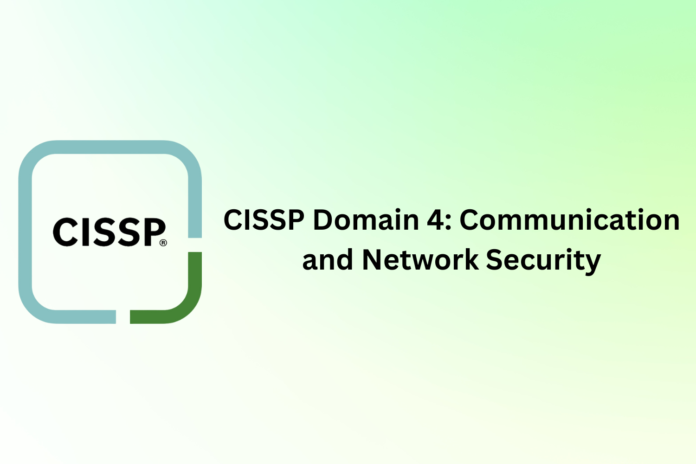CISSP Certification is the extensive part of the career of Cybersecurity specialists as it gives the understanding of the 8 CISSP Domains, important to the building of the full-featured security measures within an organisation. When it comes to protecting data transmission and network infrastructure, Domain 4: Communications and networks security forms the basis for these domains. It should be noted that CISSP Training is a must for you if the goal of your cybersecurity career is to acquire greater knowledge regarding CISSP domains and principles. This blog will have an outline of CISSP Domain 4 in that it emphasises on the important elements and the techniques to be used.
Table Of Contents
- Understanding CISSP Domains
- Exploring CISSP Domain 4: Communication and Network Security
- Critical Concepts in CISSP Domain 4
- Best Practices for CISSP Domain 4
- Conclusion
Understanding CISSP Domains
The exam for the CISSP certification is divided into eight domains that respectively demand an understanding of one aspect of cybersecurity. These fields serve as the epitome of expertise and proficiency in security management, risk assessment, and technical implementation for all the cybersecurity professionals.
Exploring CISSP Domain 4: Communication and Network Security
CISSP Domain 4, which is generally defined as network and communication security, financial privacy, and web security, has these specific topics: safe design models, the security of wireless systems, network protocols, infrastructure security and cryptography. The deal with security problems that might transpire on a basis of the network like eavesdropping, interception, and unauthorised access is entirely dependent on with how well you understand the topic areas below and how you put proper recommendations to lessen these risks.
Critical Concepts in CISSP Domain 4
Network Protocols and Technologies
There is a need of the extensive knowledge in standard network protocols and technologies such as TCP/IP, DNS, DHCP, HTTP, SSL/TLS and VPNs, among others, for every CISSP candidate. Therefore, the cyber security professionals having a packet analyser (protocols and network traffic) can promptly identify and block possible assaults exploiting the vulnerabilities discovered in the network.
Infrastructure Security
Routers, switches, firewalls and the IDS/IPS form a strong network core, which is vital to the networks’s safe and must be protected from all sources of threats. The CISSP exam can be passed if security prospective candidates who are aiming at understanding principles of security zoning, network segmentation, Access Control Lists (ACLS) have been well learned by them.
Secure Design Principles
Addressing security in network development and creation is in CISSP Domain 4, which is devoted to Secure Design Principles. Organisations may design that they provide failover redundancy, defense-in-depth, and least privilege. They can be designed in that way so that they can stand strong and resilient to face off cyber threats and attacks.
Secure Communication Channels
Ensuring about information privacy, authenticity, and integrity as there may be possibility of being tempted to go through various forms of electronic communication is pivotal for a CISSP in Domain 4. Encryption, digital signatures and a few standard algorithms are the examples of cryptography which a CISSP candidate needs to know. These secure communications, making it hard for pirates to decrypt the messages and avoiding any unauthorised persons from penetrating the data.
Wireless Security
Wireless networks are a special risk because of their exposed status to pitfalls like eavesdropping, identity spoofing, and denial-of-service (DoS) attacks. Wireless Intrusion Detection And Prevention Systems (WIDS/WIPS), authentication methods, and Wi-Fi encryption standards (such as WPA2 and WPA3) are the three major principles where CISSP 4 gives a coverage of wireless security.
Best Practices for CISSP Domain 4
Stay Updated with Emerging Technologies
Familiarise oneself with the latest innovations in network security models, protocols as well as technology to enable effective responses to emerging threats. To maintain your awareness of the latest Communication and Network Security skills, you partake of the CISSP training courses, go to industry conferences, and network with other experts.
Implement Defense-in-Depth Strategies
Installing perimeter defences, access controls, encryption, and monitoring, which are the defense-in-depth methods, should be practiced strengthening network security. Organisations that build up multifaceted layers of security and adopt a multi-layered approach are the ones that are more resilient and experience the lowest impact of security breaches.
Conduct Regular Security Assessments
It is necessary to carry out the penetration tests, the vulnerability scans, and the security assessments feature by feature to make sure that the security of the network is tightened all the time. Security spending should be a top priority of the organisations and its risk profile must be carefully analysed to tackle enduring weaknesses.
Enforce Strong Access Controls
Authentication and authorisation policies should be developed that can create a stratified network environment which permits allocation of resources to the right users. To reduce the possibility of insider threats and the accessing of unauthorised accounts through least privilege principles (RBAC) and other security measures, MFA is recommended.
Monitor and Respond to Security Incidents
Create a powerful monitoring and incident response system to detect, investigate and react toward cyber incidents right after they occur. To be more reactive in searching and solving security vulnerabilities set up an incident response team and implement (SIEM) systems and (IDS).
Conclusion
CISSP domain 4 is paramount to the CISSP certifications governing exams and protects the network infrastructure and information transfer from being attacked. Media experts demonstrate their knowledge by imparting it to build a robust network environment. They master communication and network security and grasp basic ideas, problems, and solutions. Becoming successful with CISSP certificate is not far from the reach of the candidates who are ready for lifelong learning, willing to apply knowledge in practice, and able to follow all the rules established in the cybersecurity industry. For more information visit: The Knowledge Academy.
